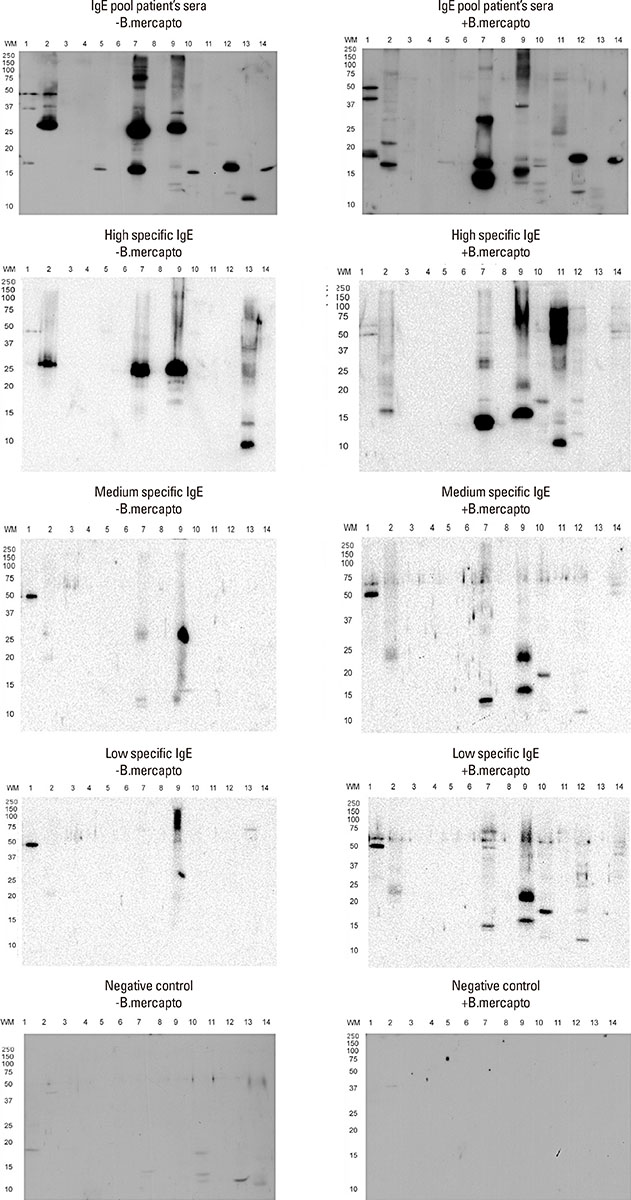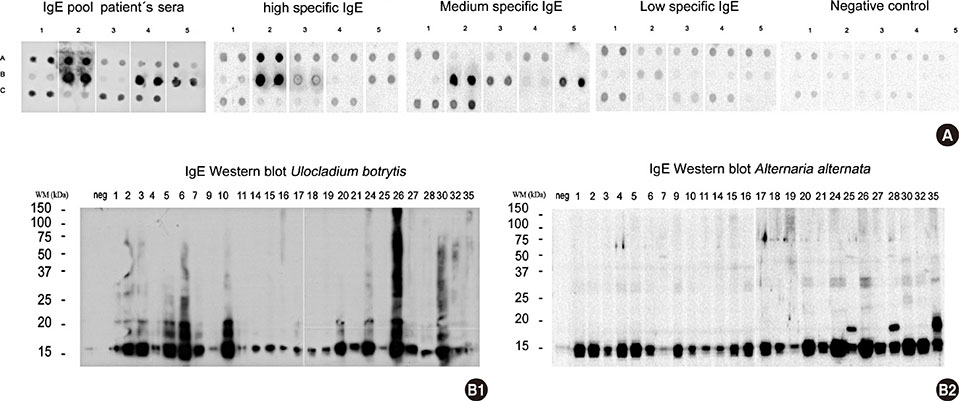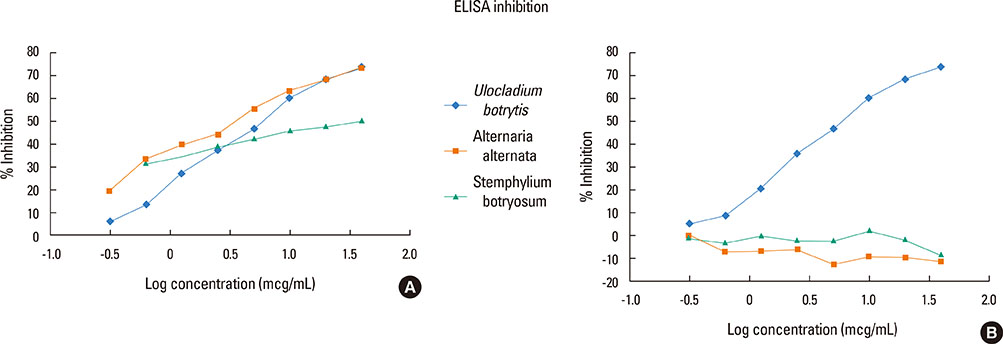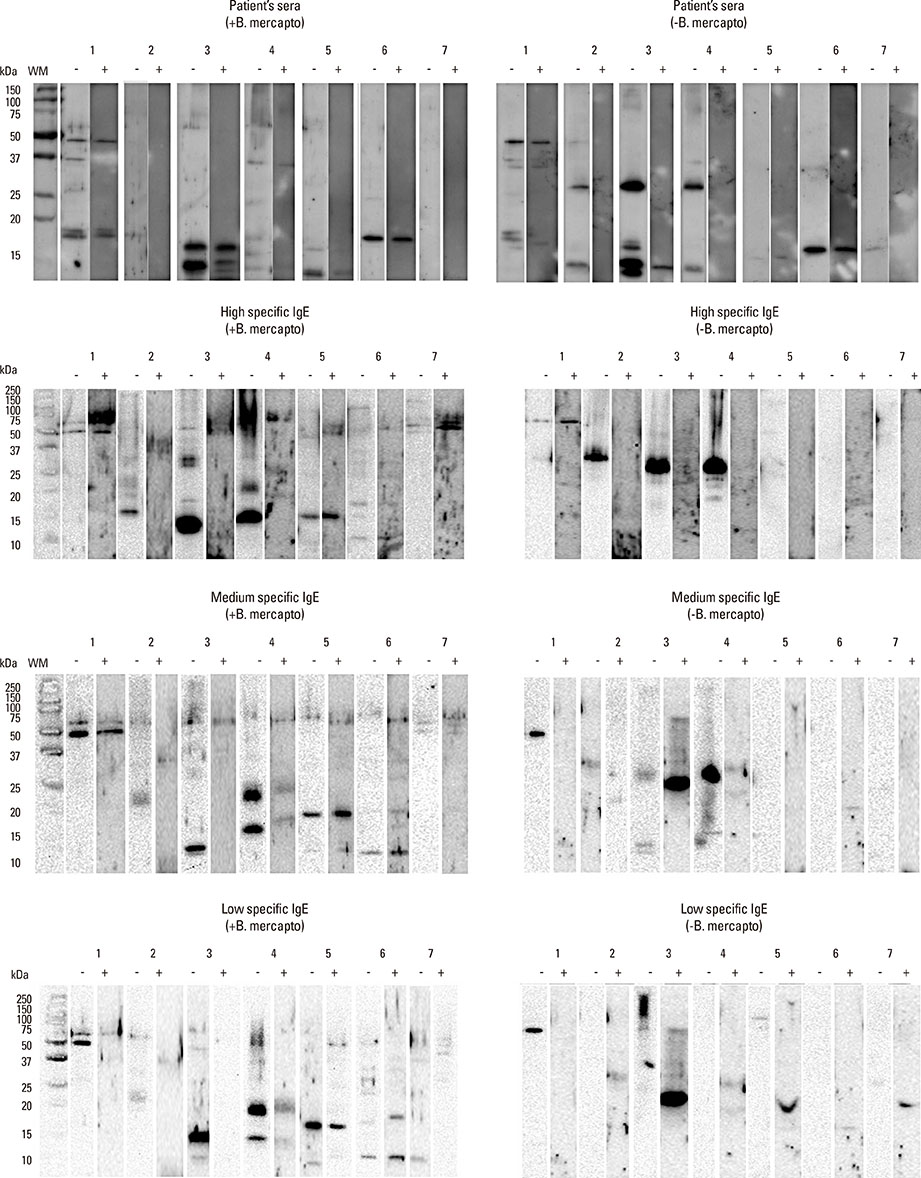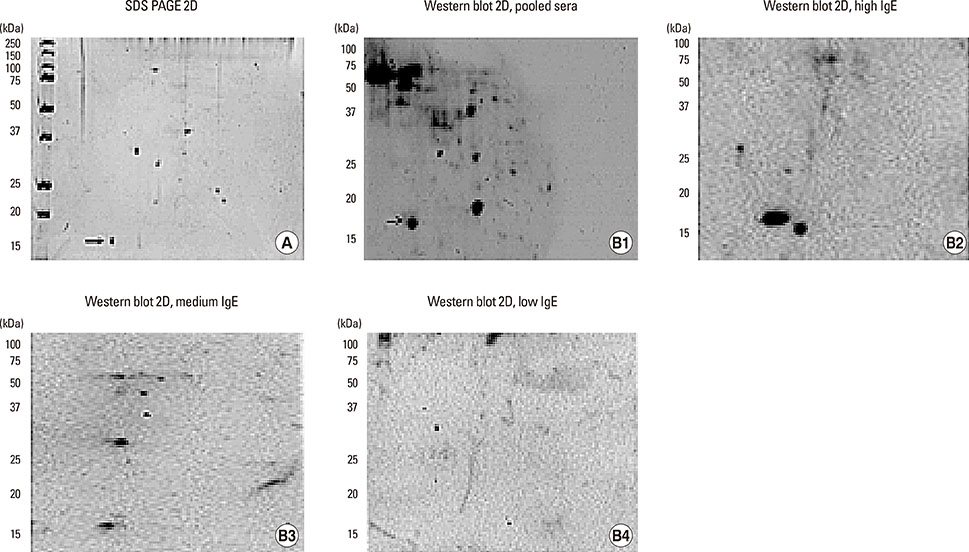Allergy Asthma Immunol Res.
2016 Sep;8(5):428-437. 10.4168/aair.2016.8.5.428.
Orthologous Allergens and Diagnostic Utility of Major Allergen Alt a 1
- Affiliations
-
- 1Allergy Service, Hospital of Cuenca, Cuenca, Spain.
- 2DIATER laboratories, Madrid, Spain. f.pineda@diater.com
- 3Department of Microbiology, School of Medicine, University Complutense of Madrid, Madrid, Spain.
- KMID: 2295152
- DOI: http://doi.org/10.4168/aair.2016.8.5.428
Abstract
- PURPOSE
Hypersensitivity to fungi is associated with rhinoconjunctivitis and asthma. For some fungi, such as Alternaria alternata (A. alternata), the symptoms of asthma are persistent, increasing disease severity and the risk of fatal outcomes. There are a large number of species of fungi but knowledge of them remains limited. This, together with the difficulties in obtaining adequate standardized extracts, means that there remain significant challenges in the diagnosis and immunotherapy of allergy associated with fungi. The type of indoor fungi related to asthma/allergy varies according to geographic, climatic, and seasonal factors, making their study difficult. The aim of this study was to determine hypersensitivity to indoor fungi in a population from Cuenca, Spain.
METHODS
Thirty-five patients with symptoms compatible with rhinitis or asthma who showed clear worsening of their symptoms in their homes or workplace were included. In vivo and in vitro tests were made with a battery of fungal allergens, including the species isolated in the home or workplace.
RESULTS
Ulocladium botrytis (U. botrytis) and A. alternata were the most representative species as a source of home sensitization. These species showed very high concordance in skin tests, specific IgE, and histamine release. The allergen Alt a 1, which was recognized in all patients, was detected in A. alternata, U. botrytis, and Stemphylium botryosum (S. botryosum).
CONCLUSIONS
U. botrytis and A. alternata were the most representative species as a source of home sensitization. Alt a 1 was recognized in all patients and may be considered a non-species-specific allergen that could be used as a diagnostic source of sensitization to some species of the Pleosporaceae family.
Keyword
MeSH Terms
Figure
Cited by 1 articles
-
Association Between Sensitization to Mold and Impaired Pulmonary Function in Children With Asthma
Jung Hye Byeon, Soohyun Ri, Oyuntulga Amarsaikhan, Eunji Kim, So Hyun Ahn, Ic Sun Choi, Hyung Jin Kim, SungChul Seo, Wonsuck Yoon, Young Yoo
Allergy Asthma Immunol Res. 2017;9(6):509-516. doi: 10.4168/aair.2017.9.6.509.
Reference
-
1. Salo PM, Arbes SJ Jr, Sever M, Jaramillo R, Cohn RD, London SJ, et al. Exposure to Alternaria alternata in US homes is associated with asthma symptoms. J Allergy Clin Immunol. 2006; 118:892–898.2. Calabria CW, Dice J. Aeroallergen sensitization rates in military children with rhinitis symptoms. Ann Allergy Asthma Immunol. 2007; 99:161–169.3. Floyer J. Violent asthma after visiting a wine cellar: a treatise on asthma. London: Innys and Parker;1745.4. Black PN, Udy AA, Brodie SM. Sensitivity to fungal allergens is a risk factor for life-threatening asthma. Allergy. 2000; 55:501–504.5. Breitenbach M, Crameri R, Lehrer SB. Impact of current genome projects on the study of pathogenic and allergenic fungi. Chem Immunol. 2002; 81:5–9.6. Horner WE, Lehrer SB, Salvaggio JE. Indoor air pollution. Fungi. Immunol Allergy Clin North Am. 1994; 14:551–566.7. Rodríguez-Rajo FJ, Iglesias I, Jato V. Variation assessment of airborne Alternaria and Cladosporium spores at different bioclimatical conditions. Mycol Res. 2005; 109:497–507.8. D'Amato G, Chatzigeorgiou G, Corsico R, Gioulekas D, Jäger L, Jäger S, et al. Evaluation of the prevalence of prick skin test positivity to Alternaria and Cladosporium in patients with suspected respiratory allergy. Allergy. 1997; 52:711–716.9. Perzanowski MS, Sporik R, Squillace SP, Gelber LE, Call R, Carter M, et al. Association of sensitization to Alternaria allergens with asthma among school-age children. J Allergy Clin Immunol. 1998; 101:626–632.10. Lorenz AR, Lüttkopf D, May S, Scheurer S, Vieths S. The principle of homologous groups in regulatory affairs of allergen products--a proposal. Int Arch Allergy Immunol. 2009; 148:1–17.11. Fung F, Clark R, Williams S. Stachybotrys, a mycotoxin-producing fungus of increasing toxicologic importance. J Toxicol Clin Toxicol. 1998; 36:79–86.12. Aas K, Backman A, Belin L, Weeke B. Standardization of allergen extracts with appropriate methods. The combined use of skin prick testing and radio-allergosorbent tests. Allergy. 1978; 33:130–137.13. Malling HJ, Dreborg S, Weeke B. Diagnosis and immunotherapy of mould allergy. VI. IgE-mediated parameters during a one-year placebo-controlled study of immunotherapy with Cladosporium. Allergy. 1987; 42:305–314.14. Skin tests used in type I allergy testing Position paper. Sub-Committee on Skin Tests of the European Academy of Allergology and Clinical Immunology. Allergy. 1989; 44:Suppl 10. 1–59.15. Stahl Skov P, Norn S, Weeke B. A new method for detecting histamine release. Agents Actions. 1984; 14:414–416.16. Wenande EC, Skov PS, Mosbech H, Poulsen LK, Garvey LH. Inhibition of polyethylene glycol-induced histamine release by monomeric ethylene and diethylene glycol: a case of probable polyethylene glycol allergy. J Allergy Clin Immunol. 2013; 131:1425–1427.17. Gallart T, Bladé J, Martínez-Quesada J, Sierra J, Rozman C, Vives J. Multiple myeloma with monoclonal IgG and IgD of lambda type exhibiting, under treatment, a shift from mainly IgG to mainly IgD. Immunology. 1985; 55:45–57.18. Pineda F. Expresión y purificación del alérgeno Alt a 1 de Alternaria alternata. Implicación en la hipersensibilidad tipo I [master's thesis]. Madrid: Universidad Complutense de Madrid;2005.19. Ceska M, Lundkvist U. A new and simple radioimmunoassay method for the determination of IgE. Immunochemistry. 1972; 9:1021–1030.20. Shevchenko A, Tomas H, Havlis J, Olsen JV, Mann M, Mann M. In-gel digestion for mass spectrometric characterization of proteins and proteomes. Nat Protoc. 2006; 1:2856–2860.21. Suckau D, Resemann A, Schuerenberg M, Hufnagel P, Franzen J, Holle A. A novel MALDI LIFT-TOF/TOF mass spectrometer for proteomics. Anal Bioanal Chem. 2003; 376:952–965.22. Gautam P, Sundaram CS, Madan T, Gade WN, Shah A, Sirdeshmukh R, et al. Identification of novel allergens of Aspergillus fumigatus using immunoproteomics approach. Clin Exp Allergy. 2007; 37:1239–1249.23. Pulendran B, Artis D. New paradigms in type 2 immunity. Science. 2012; 337:431–435.24. Patterson R. Allergic diseases. Philadelphia (PA): Lippincott Co.;1985.25. Kurth R. Regulatory control and standardization of allergenic extracts. New York (NY): Gustav Fisher Verlag;1990.26. Allergen immunotherapy: therapeutic vaccines for allergic diseases. Geneva: January 27-29 1997. Allergy. 1998; 53:1–42.27. Heinzerling L, Frew AJ, Bindslev-Jensen C, Bonini S, Bousquet J, Bresciani M, et al. Standard skin prick testing and sensitization to inhalant allergens across Europe--a survey from the GALEN network. Allergy. 2005; 60:1287–1300.28. Rivera-Mariani FE, Nazario-Jiménez S, López-Malpica F, Bolaños-Rosero B. Skin test reactivity of allergic subjects to basidiomycetes’ crude extracts in a tropical environment. Med Mycol. 2011; 49:887–891.29. Lee JH, Lee HS, Park MR, Lee SW, Kim EH, Cho JB, et al. Relationship between indoor air pollutant levels and residential environment in children with atopic dermatitis. Allergy Asthma Immunol Res. 2014; 6:517–524.30. Nelson BD. APS Features. Stachybotrys chartarum: the toxic indoor mold. St. Paul (MN): American Phytopathological Society;2001. p. 101–130.31. Gutiérrez-Rodríguez A, Postigo I, Guisantes JA, Suñén E, Martínez J. Identification of allergens homologous to Alt a 1 from Stemphylium botryosum and Ulocladium botrytis. Med Mycol. 2011; 49:892–896.32. Twaroch TE, Focke M, Fleischmann K, Balic N, Lupinek C, Blatt K, et al. Carrier-bound Alt a 1 peptides without allergenic activity for vaccination against Alternaria alternata allergy. Clin Exp Allergy. 2012; 42:966–975.33. Twaroch TE, Curin M, Valenta R, Swoboda I. Mold allergens in respiratory allergy: from structure to therapy. Allergy Asthma Immunol Res. 2015; 7:205–220.34. Asturias JA, Ibarrola I, Ferrer A, Andreu C, López-Pascual E, Quiralte J, et al. Diagnosis of Alternaria alternata sensitization with natural and recombinant Alt a 1 allergens. J Allergy Clin Immunol. 2005; 115:1210–1217.35. Postigo I, Gutiérrez-Rodríguez A, Fernández J, Guisantes JA, Suñén E, Martínez J. Diagnostic value of Alt a 1, fungal enolase and manganese-dependent superoxide dismutase in the component-resolved diagnosis of allergy to Pleosporaceae. Clin Exp Allergy. 2011; 41:443–451.36. Katotomichelakis M, Anastassakis K, Gouveris H, Tripsianis G, Paraskakis E, Maroudias N, et al. Clinical significance of Alternaria alternata sensitization in patients with allergic rhinitis. Am J Otolaryngol. 2012; 33:232–238.
- Full Text Links
- Actions
-
Cited
- CITED
-
- Close
- Share
- Similar articles
-
- Optimization of Allergen Standardization
- The Relationship between Total Serum IgE, Allergen-Specific IgE, and Skin Prick Test in Children with Atopic Asthma
- Change of causative inhalant allergens in respiratory allergic patients in Chungbuk district
- A comparison of Sensitization to Major Indoor & Outdoor Inhalant Allergens in Children with Respiratory Allergic Diseases
- Allergen standardization


